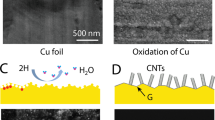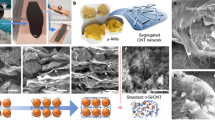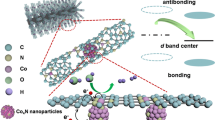Abstract
SEVERAL attempts have been made to fill carbon nanotubes1 with metals or metallic compounds to obtain nanocomposite materials with potentially interesting properties. Capillary action, predicted2 to be a filling mechanism, has been used3'4 to encapsulate lead and bismuth in open tubes. Compounds of yttrium5, manganese6 and gadolinium7 have also been encapsulated by formation of the nano-tubes in an arc discharge with the metals present in situ. Very recently, Tsang et al.8 showed that oxides of nickel, cobalt, iron and uranium can be encapsulated by opening the tubes and deposit-ing the filling material using wet chemical techniques. Here we report a search for general principles relating to the nature and structure of the filling material, using the arc-discharge method to fill tubes with fifteen metals and/or their compounds: Ti, Cr, Fe, Co, Ni, Cu, Zn, Mo, Pd, Sn, Ta, W, Gd, Dy and Yb. We find that the propensity for forming continuous 'nanowires' throughout the length of the tubes seems to be strongly correlated with the existence of an incomplete electronic shell in the most stable ionic state of the metal. We also find that the interplay between growth of the nanotube and growth of the filling results, in one case, in the formation of an unusual helical filling morphology.
This is a preview of subscription content, access via your institution
Access options
Subscribe to this journal
Receive 51 print issues and online access
$199.00 per year
only $3.90 per issue
Buy this article
- Purchase on Springer Link
- Instant access to full article PDF
Prices may be subject to local taxes which are calculated during checkout
Similar content being viewed by others
References
Iijima, S. Nature 354, 56–58 (1991).
Pederson, M. R. & Broughton, J. Q. Phys. Rev. Lett. 69, 2689–2692 (1992).
Ajayan, P. M. & Iijima, S. Nature 361, 333–334 (1993).
Ajayan, P. M. et al. Nature 362, 522–525 (1993).
Seraphin, S., Zhou, D., Jiao, J., Withers, J. C. & Loutfy, R. Nature 362, 503 (1993).
Ajayan P. M. et al. Phys. Rev. Lett. 72, 1722–1725 (1994).
Subramoney, S. et al. Carbon 32, 507–513 (1994).
Tsang, S. C., Chen, Y. K., Harris, P. J. F. & Green, M. L. H. Nature 372, 159–162 (1994).
Seraphin, S., Zhou, D., Jiao, J., Withers, J. C. & Loutfy, R. Appl. Phys. Lett. 63, 2073–2075 (1993).
Audier, M., Oberlin, A. & Coulon, M. J. Cryst. Growth 55, 549–556 (1981).
Baker, R. T. & Harris, P. S. in Chemistry and Physics of Carbon Vol. 14 (ed. Thrower, P. A.) 83–165 (Dekker, New York, 1978).
Audier, M. & Coulon, M. Carbon 23, 317–323 (1985).
Saito, Y. & Yoshikawa, T. J. Cryst. Growth 134, 154–156 (1993).
Cowley, J. M. & Liu, M. Micron 25, 53–61 (1994).
Ruoff, R. S., Lorents, D. C., Chan, B. C., Malhotra, R. & Subramoney, S. Science 259, 346–347 (1993).
Murakami, Y. et al. J. Phys. Chem. Solids 54, 1861–1870 (1993).
Author information
Authors and Affiliations
Rights and permissions
About this article
Cite this article
Guerret-Piécourt, C., Bouar, Y., Lolseau, A. et al. Relation between metal electronic structure and morphology of metal compounds inside carbon nanotubes. Nature 372, 761–765 (1994). https://doi.org/10.1038/372761a0
Received:
Accepted:
Issue Date:
DOI: https://doi.org/10.1038/372761a0
This article is cited by
-
Cobalt-based oxygen electrocatalysts for zinc-air batteries: Recent progress, challenges, and perspectives
Nano Research (2022)
-
Fundamental frequency analysis of endohedrally functionalized carbon nanotubes with metallic nanowires: a molecular dynamics study
Journal of Molecular Modeling (2021)
-
Effects of Tin on the Morphological and Electrochemical Properties of Arc-Discharge Nanomaterials
JOM (2021)
-
Enhanced field emission from copper nanowires synthesized using ion track-etch membranes as scaffolds
Journal of Materials Science: Materials in Electronics (2018)
-
An embryo of protocells: The capsule of graphene with selective ion channels
Scientific Reports (2015)
Comments
By submitting a comment you agree to abide by our Terms and Community Guidelines. If you find something abusive or that does not comply with our terms or guidelines please flag it as inappropriate.



